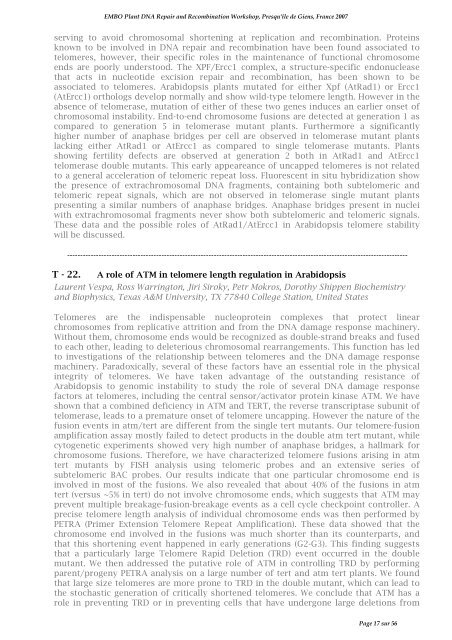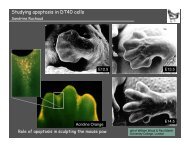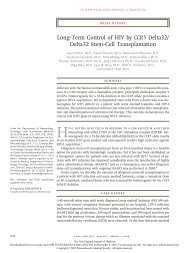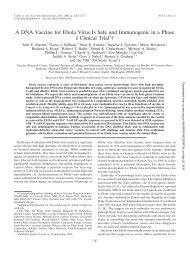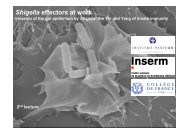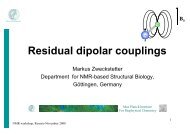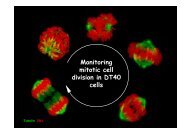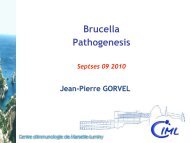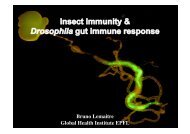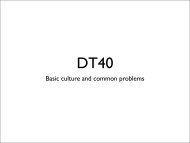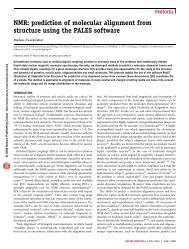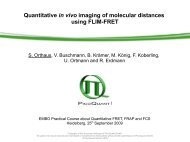pdf file - Events - EMBO
pdf file - Events - EMBO
pdf file - Events - EMBO
Create successful ePaper yourself
Turn your PDF publications into a flip-book with our unique Google optimized e-Paper software.
<strong>EMBO</strong> Plant DNA Repair and Recombination Workshop, Presqu'île de Giens, France 2007<br />
serving to avoid chromosomal shortening at replication and recombination. Proteins<br />
known to be involved in DNA repair and recombination have been found associated to<br />
telomeres, however, their specific roles in the maintenance of functional chromosome<br />
ends are poorly understood. The XPF/Ercc1 complex, a structure-specific endonuclease<br />
that acts in nucleotide excision repair and recombination, has been shown to be<br />
associated to telomeres. Arabidopsis plants mutated for either Xpf (AtRad1) or Ercc1<br />
(AtErcc1) orthologs develop normally and show wild-type telomere length. However in the<br />
absence of telomerase, mutation of either of these two genes induces an earlier onset of<br />
chromosomal instability. End-to-end chromosome fusions are detected at generation 1 as<br />
compared to generation 5 in telomerase mutant plants. Furthermore a significantly<br />
higher number of anaphase bridges per cell are observed in telomerase mutant plants<br />
lacking either AtRad1 or AtErcc1 as compared to single telomerase mutants. Plants<br />
showing fertility defects are observed at generation 2 both in AtRad1 and AtErcc1<br />
telomerase double mutants. This early appeareance of uncapped telomeres is not related<br />
to a general acceleration of telomeric repeat loss. Fluorescent in situ hybridization show<br />
the presence of extrachromosomal DNA fragments, containing both subtelomeric and<br />
telomeric repeat signals, which are not observed in telomerase single mutant plants<br />
presenting a similar numbers of anaphase bridges. Anaphase bridges present in nuclei<br />
with extrachromosomal fragments never show both subtelomeric and telomeric signals.<br />
These data and the possible roles of AtRad1/AtErcc1 in Arabidopsis telomere stability<br />
will be discussed.<br />
----------------------------------------------------------------------------------------------------------------------------------<br />
T - 22. A role of ATM in telomere length regulation in Arabidopsis<br />
Laurent Vespa, Ross Warrington, Jiri Siroky, Petr Mokros, Dorothy Shippen Biochemistry<br />
and Biophysics, Texas A&M University, TX 77840 College Station, United States<br />
Telomeres are the indispensable nucleoprotein complexes that protect linear<br />
chromosomes from replicative attrition and from the DNA damage response machinery.<br />
Without them, chromosome ends would be recognized as double-strand breaks and fused<br />
to each other, leading to deleterious chromosomal rearrangements. This function has led<br />
to investigations of the relationship between telomeres and the DNA damage response<br />
machinery. Paradoxically, several of these factors have an essential role in the physical<br />
integrity of telomeres. We have taken advantage of the outstanding resistance of<br />
Arabidopsis to genomic instability to study the role of several DNA damage response<br />
factors at telomeres, including the central sensor/activator protein kinase ATM. We have<br />
shown that a combined deficiency in ATM and TERT, the reverse transcriptase subunit of<br />
telomerase, leads to a premature onset of telomere uncapping. However the nature of the<br />
fusion events in atm/tert are different from the single tert mutants. Our telomere-fusion<br />
amplification assay mostly failed to detect products in the double atm tert mutant, while<br />
cytogenetic experiments showed very high number of anaphase bridges, a hallmark for<br />
chromosome fusions. Therefore, we have characterized telomere fusions arising in atm<br />
tert mutants by FISH analysis using telomeric probes and an extensive series of<br />
subtelomeric BAC probes. Our results indicate that one particular chromosome end is<br />
involved in most of the fusions. We also revealed that about 40% of the fusions in atm<br />
tert (versus ~5% in tert) do not involve chromosome ends, which suggests that ATM may<br />
prevent multiple breakage-fusion-breakage events as a cell cycle checkpoint controller. A<br />
precise telomere length analysis of individual chromosome ends was then performed by<br />
PETRA (Primer Extension Telomere Repeat Amplification). These data showed that the<br />
chromosome end involved in the fusions was much shorter than its counterparts, and<br />
that this shortening event happened in early generations (G2-G3). This finding suggests<br />
that a particularly large Telomere Rapid Deletion (TRD) event occurred in the double<br />
mutant. We then addressed the putative role of ATM in controlling TRD by performing<br />
parent/progeny PETRA analysis on a large number of tert and atm tert plants. We found<br />
that large size telomeres are more prone to TRD in the double mutant, which can lead to<br />
the stochastic generation of critically shortened telomeres. We conclude that ATM has a<br />
role in preventing TRD or in preventing cells that have undergone large deletions from<br />
Page 17 sur 56


